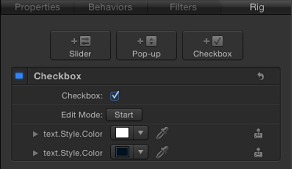About Rigging and Widgets
When you rig an object in Motion, you create a set of master controls called widgets. Widgets reside inside the rig and can affect nearly any parameter in any rigged object, including behaviors, filters, particle systems, replicators, lights, cameras and so on. Widgets can even control other widgets. There is no limit to the number of parameters each widget affects, and you can use multiple widgets in a rig to create a customized control panel where a few controls modify a wide range of parameters in the project.

You can publish widgets for use in Final Cut Pro X. When the template is opened in Final Cut Pro, only the rig controls you specified in Motion are visible, allowing you to modify a complex of parameters with a small set of controls.
Rigging is useful for a number of reasons. In addition to simplifying the workflow in template modification, rigging can be used to limit the kind and value of changes allowable in a template, ensuring that junior compositors and others in the production pipeline adhere to established specs and client needs.